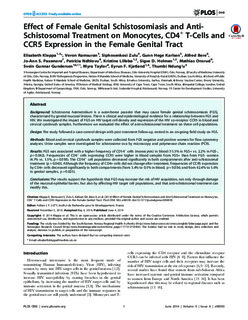| dc.contributor.author | Kleppa, Elisabeth | |
| dc.contributor.author | Ramsuran, Veron | |
| dc.contributor.author | Karlsen, Gunn Hege | |
| dc.contributor.author | Bere, Alfred | |
| dc.contributor.author | Passmore, Jo.-Ann S. | |
| dc.contributor.author | Zulu, Siphosenkosi | |
| dc.contributor.author | Ndhlovu, Patricia | |
| dc.contributor.author | Lillebø, Kristine | |
| dc.contributor.author | Holmen, Sigve D. | |
| dc.contributor.author | Onsrud, Mathias | |
| dc.contributor.author | Gundersen, Svein Gunnar | |
| dc.contributor.author | Taylor, Myra | |
| dc.contributor.author | Kjetland, Eyrun F. | |
| dc.contributor.author | Ndung’u, Thumbi | |
| dc.date.accessioned | 2014-09-26T12:17:59Z | |
| dc.date.available | 2014-09-26T12:17:59Z | |
| dc.date.issued | 2014 | |
| dc.identifier.citation | Kleppa, E., Ramsuran, V., Zulu, S., Karlsen, G. H., Bere, A., Passmore, J. A., . . . Ndung'u, T. (2014). Effect of female genital schistosomiasis and anti-schistosomal treatment on monocytes, CD4+ T-cells and CCR5 expression in the female genital tract. PLoS One, 9(6), e98593. doi: 10.1371/journal.pone.0098593 | nb_NO |
| dc.identifier.issn | 1932-6203 | |
| dc.identifier.uri | http://hdl.handle.net/11250/221810 | |
| dc.description | Published version of an article from the journal: PLoS One. Also available from the publisher:
http://dx.doi.org/10.1371/journal.pone.0098593 | nb_NO |
| dc.description.abstract | BACKGROUND: Schistosoma haematobium is a waterborne parasite that may cause female genital schistosomiasis (FGS), characterized by genital mucosal lesions. There is clinical and epidemiological evidence for a relationship between FGS and HIV. We investigated the impact of FGS on HIV target cell density and expression of the HIV co-receptor CCR5 in blood and cervical cytobrush samples. Furthermore we evaluated the effect of anti-schistosomal treatment on these cell populations. DESIGN: The study followed a case-control design with post treatment follow-up, nested in an on-going field study on FGS. METHODS: Blood and cervical cytobrush samples were collected from FGS negative and positive women for flow cytometry analyses. Urine samples were investigated for schistosome ova by microscopy and polymerase chain reaction (PCR). RESULTS: FGS was associated with a higher frequency of CD14+ cells (monocytes) in blood (11.5% in FGS+ vs. 2.2% in FGS-, p = 0.042). Frequencies of CD4+ cells expressing CCR5 were higher in blood samples from FGS+ than from FGS- women (4.7% vs. 1.5%, p = 0.018). The CD14+ cell population decreased significantly in both compartments after anti-schistosomal treatment (p = 0.043). Although the frequency of CD4+ cells did not change after treatment, frequencies of CCR5 expression by CD4+ cells decreased significantly in both compartments (from 3.4% to 0.5% in blood, p = 0.036; and from 42.4% to 5.6% in genital samples, p = 0.025). CONCLUSIONS: The results support the hypothesis that FGS may increase the risk of HIV acquisition, not only through damage of the mucosal epithelial barrier, but also by affecting HIV target cell populations, and that anti-schistosomal treatment can modify this. | nb_NO |
| dc.language.iso | eng | nb_NO |
| dc.publisher | Public Library of Science | nb_NO |
| dc.rights | Navngivelse 3.0 Norge | * |
| dc.rights.uri | http://creativecommons.org/licenses/by/3.0/no/ | * |
| dc.title | Effect of female genital schistosomiasis and anti-schistosomal treatment on monocytes, CD4+ T-cells and CCR5 expression in the female genital tract | nb_NO |
| dc.type | Journal article | nb_NO |
| dc.type | Peer reviewed | nb_NO |
| dc.subject.nsi | VDP::Medical disciplines: 700::Clinical medical disciplines: 750::Tropical medicine: 761 | nb_NO |
| dc.source.pagenumber | e98593 | nb_NO |
| dc.source.volume | 9 | nb_NO |
| dc.source.journal | PLoS One | nb_NO |
| dc.source.issue | 6 | nb_NO |
| dc.identifier.doi | 10.1371/journal.pone.0098593 | |

